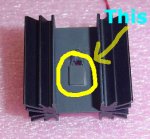Upon reconsideration many of the nonlinear regression methods are probably overkill and intended for more complex problems. I am leaning more towards treating the numbers as an infinite series.
The sum of an infinite series is given by:
a / (1 - r)
Where a is the first term and r is the ratio between terms (r < 1).
Create a series using the differences between successive values and its sum will be the difference between the oldest value and the asymptote.
Ex:
Original Data:
2, 3, 3.5, 3.75
Differences:
1, 0.5, 0.25
a = 1, r = 0.5, sum = 2.
The series will converge at sum + initial value or 2 + 2 = 4.
You will of course have to average the ratios between each term and probably keep a floating average of the final values to make everything nice and smooth. I would also skip the math if r < 0.1 or something, negative ratios may start doing bad things.
I can always code up a sample function in Java or something.
IMO refine the sensor a bit, stick it all in a box with a PIC and LCD and you have a winner. If you program it to self-calibrate with a 5 minute cycle or something and can make them for 30-40$ accuracy in the +-10% would be fine.
The sum of an infinite series is given by:
a / (1 - r)
Where a is the first term and r is the ratio between terms (r < 1).
Create a series using the differences between successive values and its sum will be the difference between the oldest value and the asymptote.
Ex:
Original Data:
2, 3, 3.5, 3.75
Differences:
1, 0.5, 0.25
a = 1, r = 0.5, sum = 2.
The series will converge at sum + initial value or 2 + 2 = 4.
You will of course have to average the ratios between each term and probably keep a floating average of the final values to make everything nice and smooth. I would also skip the math if r < 0.1 or something, negative ratios may start doing bad things.
I can always code up a sample function in Java or something.
IMO refine the sensor a bit, stick it all in a box with a PIC and LCD and you have a winner. If you program it to self-calibrate with a 5 minute cycle or something and can make them for 30-40$ accuracy in the +-10% would be fine.





